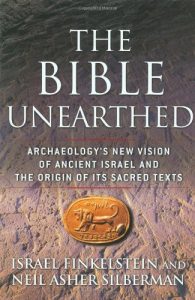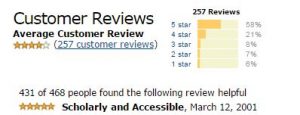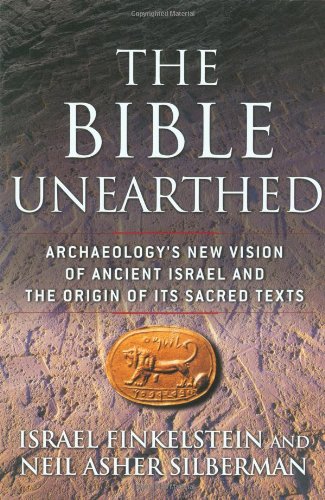 I initially discovered The Bible Unearthed, when searching the Ashland Seminary Library for resources that might help me with some research on Akkadian archaeology from the same time period as our OT time periods. It did not really help me that much with my research paper but the second chapter on the Exodus archaeology was so interesting that I just kept the book and paid the Library’s lost book fine for it. (In retrospect, I probably could have just bought the Kindle version for $13.99 and saved $40.00 and some paperwork).
I initially discovered The Bible Unearthed, when searching the Ashland Seminary Library for resources that might help me with some research on Akkadian archaeology from the same time period as our OT time periods. It did not really help me that much with my research paper but the second chapter on the Exodus archaeology was so interesting that I just kept the book and paid the Library’s lost book fine for it. (In retrospect, I probably could have just bought the Kindle version for $13.99 and saved $40.00 and some paperwork).
“The Bible Unearthed”
Archaeology’s New Vision of Ancient Israel and the Origin of Sacred Texts
By: Israel Finkelstein & Neil Asher Silberman
About the Authors:
Israel Finkelstein is Professor of the Archaeology of Israel in the Bronze Age and Iron Ages at Tel Aviv University and is also the co-director of excavations at Megiddo in northern Israel. He completed his studies at Tel Aviv University and wrote his Ph.D. thesis on the excavations at Izbet Sartah, an early Iron site, for which he served as field director.
Neil Asher Silberman is an archaeologist and historian. He is a graduate of Wesleyan University and was trained in Near Eastern archaeology at the Hebrew University of Jerusalem. Awarded a 1991 Guggenheim Fellowship, he is a contributing editor for Archaeology Magazine.
Overview:
The Bible Unearthed is a balanced, thoughtful, bold reconsideration of the historical period that produced the Hebrew Bible. The headline news in this book is easy to pick out: there is no evidence for the existence of Abraham, or any of the Patriarchs; ditto for Moses and the Exodus; and the same goes for the whole period of Judges and the united monarchy of David and Solomon. In fact, the authors argue that it is impossible to say much of anything about ancient Israel until the seventh century B.C., around the time of the reign of King Josiah. In that period, “the narrative of the Bible was uniquely suited to further the religious reform and territorial ambitions of Judah.” Yet the authors deny that their arguments should be construed as compromising the Bible’s power. Only in the 18th century–“when the Hebrew Bible began to be dissected and studied in isolation from its powerful function in community life”–did readers begin to view the Bible as a source of empirically verifiable history. For most of its life, the Bible has been what Finkelstein and Silberman reveal it once more to be: an eloquent expression of “the deeply rooted sense of shared origins, experiences, and destiny that every human community needs in order to survive,” written in such a way as to encompass “the men, women, and children, the rich, the poor, and the destitute of an entire community.” –Michael Joseph Gross
First Impression
My first impression when reading this book was that it might be attempting to support Christianity through archaeology. At least, the title made it sound as though it might. But as soon as I started reading it I discovered that it was quite the opposite. In fact, in many areas the author makes pretty bold claims about the inaccuracy of the Bible even when the archaeological information seems to be scant. However, I still really felt as though the evidence presented was very helpful for any student of archaeology, even if we might all draw different conclusions from the evidence.
Packaging
The first copy I read was a thick hard covered version from the library. It had a white dust jacket and felt much like a text book. The copy that I actually own today is a paperback with a relatively light weight to it and it can fit into any bag. I have not downloaded the Kindle format but it does exist, which I usually recommend for anyone on the go.
The Content
 The book is sectioned off very well. You can look at the table of contents and find lots of topics and divisions. It turns the book into a reference tool of sorts for those who need to use it as such. It’s also very readable as a standard book. One could start on page 1 and read through to the end without feeling overwhelmed or feeling that the chapters are disconnected.
The book is sectioned off very well. You can look at the table of contents and find lots of topics and divisions. It turns the book into a reference tool of sorts for those who need to use it as such. It’s also very readable as a standard book. One could start on page 1 and read through to the end without feeling overwhelmed or feeling that the chapters are disconnected.
The book also contains a healthy number of maps, charts, images, and resources to help illustrate certain items. The end of the book has a rather large section with various appendices that will be helpful to the reader.
The chapters are also ordered chronologically so if there is a certain time period of interest one would only have to navigate to that chapter and then they should be able to find what they are looking for.
The Best parts
My favorite part of the book is the Author’s proclivity for examining many angles of every piece of evidence. The book is very data-heavy and it provides the reader with as much information as they can likely consume in a short sitting.
I also enjoyed the sections and method of presenting the evidence. The book does not blindly present information. It tries to address a specific question or topic in each chapter and then presents the evidence for the question at hand. For example, chapter 2 asks the question “Did the Exodus Happen?” Chapter 6 is “One State, One Nation, One People?”
The sections also try to follow a time line. Thus, if a reader wants to read about archaeology finds during the pre-Akkadian invasion they can find chapters 8-10 which would address that time period.
In short, the book is supremely organized and easy to read. It can be read straight through or section by section. The authors are very well researched and the bibliography is chock full of resources for further reading.
The Worst parts
The authors tend to come from a skeptical perspective on many things and they tend to throw the baby out with the bathwater. For example, in the section covering the conquest of Canaan they are quick to point out some of the evidence that would disprove such a conquest, while explicitly ignoring the content that seems in favor of the conquest. It’s not a huge issue since all authors have a bias one way or another and the text presents a lot of information for the reader to make up there own mind.
The information in the book is also slightly dated. I do not want to sound too negative on this point because the data in the book is excellent. However, the reader needs to be aware the new archaeological data has been discovered since this book was assembled. It’s not to say that the new data invalidates the data in this book but just be aware that what is in this book is not representative of all of the archaeological data available. No book can possibly contain all the data available, much less be continually updated with new data.
Summary
 This is a great book for any student of biblical archaeology. I would also suggest it for anyone seriously considering studying the history and textual criticism of the Bible. It’s rated incredibly well on every website where it’s sold.
This is a great book for any student of biblical archaeology. I would also suggest it for anyone seriously considering studying the history and textual criticism of the Bible. It’s rated incredibly well on every website where it’s sold.
You can use this as a reference for academic work and also read for pleasure. The price has come down on this book drastically for the paper back version since the last revision and it’s a LOT cheaper than it was back when it was only available in hard cover. The Kindle version is even cheaper still yet.

Well to begin with, before even reading the book ..the fact that there is no evidence means not much …the truth is that lack of evidence is not at all evidence of lack …many murder cases are tried without evidence … Meaning without physical evidence – ie: this is the staff with which Moses split the sea ..etc …circumstantial evidence has been enough to put many criminals behind bars .. the history of the Jewish people and our .. continued existance from generation to generation …is good circumstantial evidence ..
You should read the book. The issue isn’t a lack of evidence…. It’s contradictory evidence.